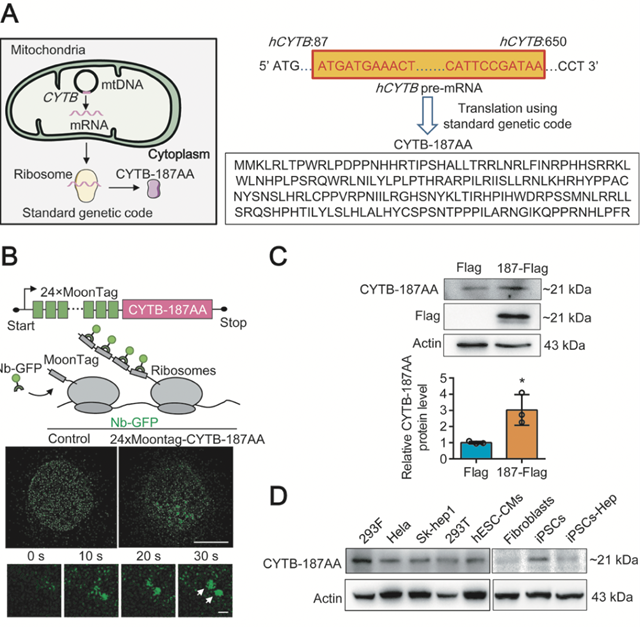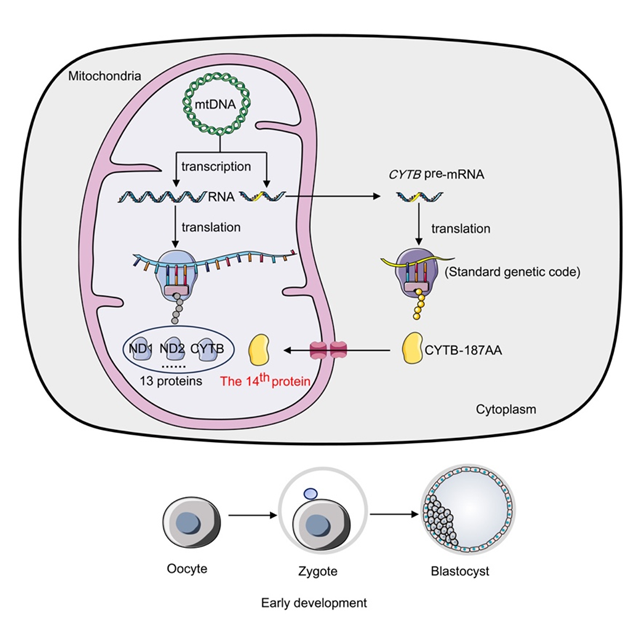Mitochondrial DNA-encoded 14th Protein Discovered from Cytosolic Translation
The mitochondrial genome has generally been understood to contain 37 genes, including 13 genes coding for proteins, 22 genes coding for transfer RNAs (tRNA) and 2 genes coding for ribosomal RNAs (12S and 16S rRNAs). Mitochondrial mRNAs are translated by mitochondrial ribosomes using a variant genetic code, i.e. the standard isoleucine code, ATA, encodes methionine in mitochondria; the arginine codes, AGA and AGG, are stop codons; the stop codon, TGA, encodes tryptophan. Mitochondrial RNAs such as sncmtRNAs, LIPCAR, lncCYTB and rRNAs are exported out of mitochondria and are associated with various physiological and pathological processes including cancer, heart failure, aging and early embryogenesis. However, the possibility of translation of 13 mitochondrial gene encoded mRNAs by cytosolic ribosomes has not previously been recognized or explored.
Prof. LIU Xingguo's research group at the Guangzhou Institutes of Biomedicine and Health (GIBH), Chinese Academy of Sciences published a paper titled "A novel protein CYTB-187AA encoded by the mitochondrial gene CYTB modulates mammalian early development" in Cell Metabolism. They demonstrate that cytochrome b (CYTB), the only mitochondrial-DNA-encoded transcript among complex III, mitochondrial encodes an unrecognized 187 amino-acid-long protein, CYTB-187AA, with mitochondrial DNA-encoded protein arising from cytosolic translation (mPACT) pattern, playing important roles in early development including female fertility and primed-to-na?ve transition. For the first time, they uncovered a dual translation pattern of a mitochondrial mRNA and demonstrated the physiological function of this 14th protein encoded by mitochondrial DNA.
The researchers first used characteristic peptides identified by liquid chromatography tandem mass spectrometry (LC-MS/MS) that were determined with purified recombinant CYTB-187AA by filtering human proteome peptides, they performed parallel reaction monitoring (PRM)-MS and identified five matched endogenous characteristic peptides of CYTB-187AA in human cells (hESC-CMs, SK-hep1, 293T, 293F) and one matched endogenous characteristic peptide in mouse cell (mouse ESCs). Innovatively, for the first time, mass spectrometry was used to identify endogenous proteins encoded by mitochondrial DNA and translated in the cytoplasm.
Next, researchers visualized the translation of CYTB-187AA mRNAs at cytosolic ribosomes using the MoonTag system, and further detected CYTB-187AA is relatively highly expressed in many cells by a customized mouse monoclonal antibody raised against CYTB-187AA. The researchers used Rho0 cells without mitochondrial DNA and WT cells, and treated cells with ethidium bromide (EB), which inhibits mitochondrial DNA replication and transcription, and IMT1B, a specific mitochondrial RNA polymerase inhibitor that inhibits mitochondrial DNA transcription, and EU imaging. Experimental evidence strongly suggested that cytoplasmic localized CYTB mRNAs is derived from mitochondrial DNA.
The researchers found that CYTB-187AA is mainly colocalized with the matrix through a 37-amino acid targeting signal at the N-terminus by Hessian-structured illumination microscopy (SIM), super-resolution microscopy. They revealed that CYTB-187AA promotes the pluripotent state in primed-to-na?ve transition by interacting with SLC25A3 to modulate ATP production. They further generated a transgenic knock-in mouse model of CYTB-187AA silencing and found that reduction of CYTB-187AA impairs females’ fertility by decreasing the number of ovarian follicles.
In summary, in this study, researchers discovered a dual translation pattern of the mitochondrial encoded gene CYTB whereby, in addition to producing CYTB in complex III, CYTB also encodes a new, mitochondrial matrix localized protein, CYTB-187AA that is translated by cytosolic ribosomes using the standard genetic code. For the first time, the researchers provided solid evidences for the existence of mPACT.

A 187 amino acid ORF in the CYTB coding region encodes a novel protein, CYTB-187AA, using the standard genetic code (Image by GIBH)

Model of the generation and function of CYTB-187AA (Image by GIBH)
Contacts:
Xingguo Liu, Ph.D., Principal Investigator;
Guangzhou Institutes of Biomedicine and Health, Chinese Academy of Sciences, Guangzhou, China, 510530.
Email:liu_xingguo@gibh.ac.cn
Attachment Download:
-
Contact
-
Reference
-
Related Article